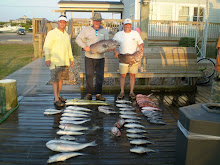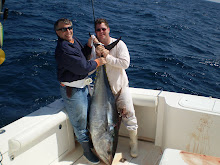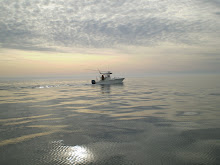
Spring fishing off Hatteras brings with it an opportunity to catch mackerel, both king and spanish varieties. Over the years, we've caught both on the
Sea Ya Bea, and taken them home to the dinner table. Mackerel are an oily fish, and too "fishy" for some palettes. Personally, I love them and try to introduce citrus into the equation, usually fresh lemon slices laid on top under the broiler, and then squeezed lemon juice with freshly ground pepper. In today's
Wall Street Journal, a professional chef weighs in with a recipe. Skimming the text, it sounded good--and what the heck, we need all the fish recipes we can get, at least to consider. After all, one never knows where new favorites dishes might surface from. Give it a quick read.
Spanish Mackerel With Blood Orange and Anchovy Sauce
The Chef:
Anita Lo
Her Restaurant:
Annisa in Manhattan's West Village
What She's Known For:
Weaving multicultural flavors with classic French themes
Anita Lo, chef and owner of Manhattan restaurant Annisa (which means "women" in Arabic), has a palate that knows no boundaries.
The Michigan native says her family obsessed over food when she was growing up. Her mother, a Chinese doctor, prepared multi-course Malaysian feasts and her stepfather, an American with New England roots, was a master of German cookery. She also had nannies who cooked delicious Polish food.
Though Ms. Lo's dishes are rooted in classical French technique (she studied at Paris's École Ritz-Escoffier), she plays with a range of global flavors. When creating a dish, Ms. Lo says she likes to take "an ingredient outside its context," be it Chinese, Japanese or French, and push it in a new direction. For example, on Annisa's winter menu, Chinese soup dumplings are filled with foie gras and roasted rack of lamb is served with South African elements such as tamarind chutney and a gussied up version of bobotie, a national South African ground meat and egg casserole. In her forthcoming cookbook, "Cooking Without Borders: Flavors for the New American Kitchen," Ms. Lo will share other recipes that blur geographical and cultural lines.
For her second of four Slow Food Fast contributions, Ms. Lo shares a winter recipe for broiled Spanish mackerel with a blood orange anchovy sauce. Spanish mackerel, she says, is a fish that's ideal in cold months because it gets fattier in winter, making its meat richer and all the more delicious. It's an oily fish that works well with the balance of citrus. Fat, she stresses, needs acid. At Annisa, Ms. Lo serves Spanish mackerel raw and thinly sliced with oranges, shaved raw broccoli rapini and a confited mustard seed oil.
Here, she has created a more approachable recipe that calls for broiled fillets served with a quick pan sauce. Broiling, she says, is a simple technique that "makes the skin nice and bubbly and crispy."
However easy this elegant dish may be, Ms. Lo advises home chefs to make sure they don't overcook the fish and that the broiler is good and hot before cooking.
This meal is brighter and lighter than most cold-weather indulgences. Ms. Lo balances the oily mackerel with a sauce made of blood oranges, which are also in season at the moment. More than just a visual flourish, the orange sections are worth the busy work they require—they add acidity and elegance to the final dish. The anchovy, which dissolves into the olive oil, lends the sauce depth and earthiness Though simplified for home cooks, this dish bears Ms. Lo's sophisticated mark.
 Broiled Spanish Mackerel with Orange and AnchovyFRESHEST FISH
Broiled Spanish Mackerel with Orange and AnchovyFRESHEST FISH: Mackerel tends to be more oily—and succulent—in the winter months.
4 five-ounce fillets Spanish mackerel, skin on
6 tablespoons olive oil
Salt and pepper
2 tablespoons minced shallots
1 clove garlic, peeled and thinly sliced
Zest of ½ a lemon, grated
Zest of ½ an orange, grated
Pinch of red pepper flakes
4 anchovy fillets, rinsed, patted dry and finely sliced
½ cup orange juice
1 tablespoon butter
2 blood oranges, sectioned
Lemon, for seasoning
Snipped chives (optional)
What to Do:1. Heat a broiler on high. Brush both sides of mackerel with 3 tablespoons olive oil and season with salt and pepper.
2. Place mackerel, skin side up, on the top oven rack. Cook until skin is blistered and the fish is almost cooked through, about 3-5 minutes. Transfer to a warm plate.
3. Place a medium sauté pan over high heat. Add olive oil, shallot, garlic, zests, pepper flakes and anchovies to the pan. Cook until sizzling.
4. Add orange juice and bring to a boil. Reduce heat to low and cook for 3 minutes, or until thickened.
5. Turn off heat and swirl in butter. Gently stir in the orange sections. Season the pan sauce with salt, pepper and a squirt of lemon juice.
6. Divide sauce among 4 plates. Top with mackerel fillets and garnish with chives if desired.































